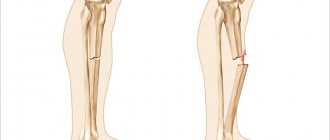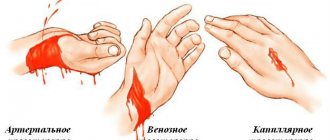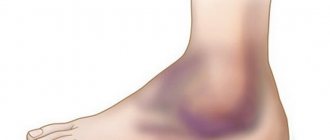Quickly and correctly provided first aid for bleeding is the key to a successful recovery of the victim.
The first aid algorithm depends on the type of bleeding. There are 4 types:
| Arterial | Represents the greatest danger. The blood flows quickly and is scarlet in color. |
| Venous | The blood flows out more slowly and is dark red in color. |
| Capillary | The blood comes out slowly and in a small volume, and has a bright red color. It may appear as small red drops on a person's skin. |
| Internal | The danger of this type of bleeding is that it is quite difficult to determine its presence in a person. Symptoms of internal bleeding depend on its location, most often the person becomes weak and pale, his pulse quickens (up to 140/min), he feels dizzy, has weak breathing, a swollen painful abdomen in the “embryo” position, and there may be a bruise on the abdomen. |
Emergency care for arterial bleeding
Remember that in case of arterial bleeding you cannot hesitate!
Quickly assess the situation and proceed to provide assistance. First of all, pinch the artery with your finger:
If bleeding is in the face area, press your finger on the corner of the lower jaw.
If bleeding is from the head area, then press your finger on the temporal bone in front of the ear.
If bleeding is in the area of the shoulder joint, then press the subclavian artery to the rib.
If bleeding is in the area of the hand, then press the brachial artery to the bone from the side of the shoulder.
If there is bleeding in the thigh area, then you need to press your fist on the frontal bone in the groin area.
Next you need to apply a tourniquet. To temporarily stop arterial bleeding, an Esmarch tourniquet or improvised rubber material is used. Rules for applying a tourniquet:
- Raise, if possible, the victim's arm/leg - this will lead to the outflow of venous blood from the limb;
- Place the tourniquet over the victim’s clothing or a piece of fabric: this is necessary so as not to injure the person’s skin.
- The first 2 turns need to be made the tightest, the crosshair is applied on the back side of the artery. Make sure that the bleeding from the wound has stopped and the skin below the tourniquet has turned pale.
- The victim should be immediately sent to the hospital or call an ambulance.
If you do not achieve complete disappearance of the pulse on the radial artery, then within 10-15 minutes the hand will swell and turn blue. Then the tourniquet can be removed only if the arm is amputated. Record the time of application of the tourniquet. The maximum permissible time in summer is 90 minutes, in winter – 60 minutes, otherwise tissue necrosis occurs.
Every 30-40 minutes, regardless of the time of year, you should remove the tourniquet for 20-30 seconds (until the skin below its application turns pink). This is done so that blood can enter the damaged limb to supply it with oxygen and remove metabolic products.
Then the tourniquet should be applied again below or above its previous location. You can do this for several hours.
Rules for applying a tourniquet
A tourniquet is applied only to stop arterial bleeding, and also if an arm or leg was amputated as a result of injury. In other cases, the use of a tourniquet is not advisable due to the high degree of injury to the skin and soft tissues. To temporarily stop bleeding, you can use an Esmarch tourniquet or a handy rubber material.
Rules for applying a tourniquet for bleeding
Basic rules and sequence of applying a tourniquet:
- If possible, raise your arm or leg for a few seconds and fix it in a comfortable position - this will lead to the outflow of venous blood.
- The tourniquet is applied over clothing or a piece of fabric is placed under it. This is necessary to protect the skin.
- The first two turns need to be made as tight as possible, they are the ones who stop the blood, while the crosshair is applied on the back side of the artery.
- The maximum duration of applying a tourniquet in the warm season should not exceed 90 minutes, in the cold season - 60 minutes. If during this time the victim cannot be taken to the hospital, the tourniquet should be loosened for 10-15 minutes and the artery should be pressed with a finger. Then the tourniquet is applied again, 1-2 cm above or below the previous location. The duration of applying a tourniquet to children should not exceed an hour.
- The time for applying the tourniquet must be written down and attached in a visible place. In reality, due to problems with drawing up (searching for paper and pens in field or combat conditions, while there are more pressing tasks of saving the life of the victim) and preserving (the paper gets soaked in blood and spreads or is simply lost) notes, in modern In practice, it is customary to write the time of application of the tourniquet with a marker directly on a visible place on the body, for example, it could be the forehead; it is recommended to indicate the name of the rescuer or the person who applied the tourniquet.
Esmarch rubber hemostatic tourniquet
Indications:
- traumatic amputation of a limb;
- inability to stop bleeding with other known means.
Advantages:
- quite fast and the most effective way to stop bleeding from the arteries of the limb.
Flaws:
- the use of a tourniquet leads to complete bleeding of the distal limbs due to compression of not only damaged great vessels, but also collaterals, which for more than 2 hours can lead to gangrene;
- nerve trunks are compressed, which causes post-traumatic plexitis with subsequent pain and orthopedic syndrome;
- cessation of blood circulation in the limb reduces the resistance of tissues to infection and reduces their regenerative abilities;
- the use of a tourniquet can cause severe vasospasm and lead to thrombosis of the operated artery;
- restoration of blood circulation after use of a tourniquet contributes to the development of tourniquet shock and acute renal failure;
- the use of a tourniquet is impossible on the torso or is limited in anatomically difficult areas.
Errors:
- its use without indications, that is, for venous and capillary bleeding;
- application on a naked body;
- far from the wound;
- weak or excessive tightening;
- poor fastening of the ends of the tourniquet;
- lack of accompanying note;
- use more than 2 hours;
- covering the tourniquet with a bandage or clothing.
If there is severe bleeding, a tourniquet is applied to the upper third of the shoulder or middle third of the thigh. In these areas, the anatomical location of the humerus and femur makes it possible to stop the bleeding with maximum efficiency. Applying a tourniquet in other places will not give the desired result. If a limb is torn off, applying a tourniquet is mandatory even in the absence of bleeding.
If the tourniquet is applied correctly, characteristic signs will appear after a while. The limb below the application site will turn pale and cold, the bleeding will stop, and the peripheral pulse will not be palpable. The intersection of the tourniquet should be on the outside of the arm or leg, since the artery is located on the axillary side.
First aid for venous bleeding
With venous bleeding, a stream of blood comes to the surface at high speed so that it does not allow a blood clot to form and stop the bleeding.
As a result, a person may lose a large amount of blood.
Algorithm for providing assistance:
- Raise the injured limb upward;
- Cover the wound with a bandage or clean cloth folded several times;
- Cover the wound tightly with a bandage.
In case of severe venous bleeding, a tourniquet is applied and then cold is applied to the wound. Next, go to the hospital for help.
Symptoms of bleeding from capillaries
Blood loss from capillaries has the most favorable outcome of all types of bleeding. In the normal state of the body, the bleeding wound surface quickly thromboses, which usually causes a small amount of blood to leak out. Life-threatening conditions may occur under the following conditions:
- large area of skin damage;
- high ambient temperature;
- bleeding disorders (hemorrhagic vasculitis, hemophilia);
- severe diseases (oncology, jaundice, sepsis, scarlet fever);
- increased blood pressure;
- hypovitaminosis (vitamin C, K).
With significant blood loss as a result of concomitant unfavorable factors, the following symptoms appear:
- weakness, drowsiness;
- pale skin, beads of sweat;
- dryness of the oral mucosa;
- increased heart rate, decreased blood pressure;
- dizziness, lightheadedness;
- nausea;
- rapid breathing;
- darkening of the eyes.
With external bleeding, the bleeding area of the body is determined; with internal blood loss, the pathological process can be suspected by the blood content in the secreted fluids. In the case of pulmonary hemorrhage, “rusty” sputum is released, gastrointestinal hemorrhage produces vomit in the form of “coffee grounds”, brown feces, and renal hemorrhage produces red urine.
Emergency care for capillary bleeding
With capillary bleeding, an infection can enter the human body through the wound. To prevent this from happening, the wound must be treated and bandaged.
Algorithm for providing assistance:
- If the wound is dirty, it should be washed with water;
- Treat the wound with hydrogen peroxide;
- Apply a bandage to the wound or place an antibacterial patch over the wound.
Nosebleeds can stop on their own, but in severe cases first aid must be provided:
- Sit the victim down with his head slightly forward and let the blood drain.
- Apply cold (ice, cold pack, etc.) to the bridge of your nose.
- Press the wing of your nose against the nasal septum - the bleeding should stop within 10 minutes.
- If this does not happen, rolled gauze swabs must be placed in the nasal cavity. If bleeding in this case continues after 10 minutes, send the victim to the hospital.
Types of bleeding
The type of bleeding depends on which vessel is damaged, in which part of the body it is localized, and the intensity of blood loss.
Classification according to the type of damage to blood vessels:
- capillary bleeding;
- venous;
- internal (parenchymal);
- arterial;
- mixed bleeding.
Classification according to the cause of bleeding:
- abnormal bleeding;
- traumatic.
Classification according to the location of blood loss:
- external;
- internal.
Classification by volume of blood loss:
On average, about 5 liters of blood circulates in the body of an adult. Depending on the volume of fluid spilled, doctors distinguish the following degrees of blood loss:
- mild degree (less than 0.5 liters);
- medium (less than 1 liter);
- heavy (about 1.5 liters);
- massive (about 2.5 liters);
- lethal (about 3 liters), i.e. more than half of the total blood volume;
- absolutely lethal (more than 3.5 liters), i.e. above 60%.
First aid for bleeding is a system of therapeutic and preventive measures that must be taken in case of damage to blood vessels (arteries, capillaries and veins) until qualified medical assistance becomes available. Each type of bleeding has its own characteristics in providing assistance.
Types and signs of external bleeding
Methods to stop bleeding largely depend on their location. Each type has its own external manifestations, to which you need to react in time:
- capillary bleeding - occurs due to damage to small vessels as a result of injury or illness. It manifests itself first in the form of blood dew, and then as a slow flow of blood beyond the skin. This condition can be especially dangerous for people with bleeding disorders;
- internal (parenchymal) bleeding is a rather dangerous condition observed as a result of damage to internal organs that have a large blood supply network (spleen, liver, kidneys);
- arterial bleeding is the result of damage to the aorta, femoral and other arteries and manifests itself in the form of a stream of bright scarlet color with pulsation. The danger of such blood loss is its rapid nature, and therefore the timeliness of assistance in fractions of a second plays a vital role in avoiding death caused by damage to the main artery;
- venous bleeding is the slowest. The blood flows out thick, dark burgundy in color, and clots may form. Bleeding from a damaged vein is dangerous due to the detachment of a blood clot, significant loss of blood, or the entry of air bubbles into a pulmonary vessel.









